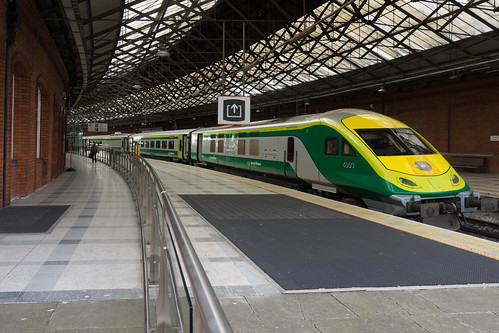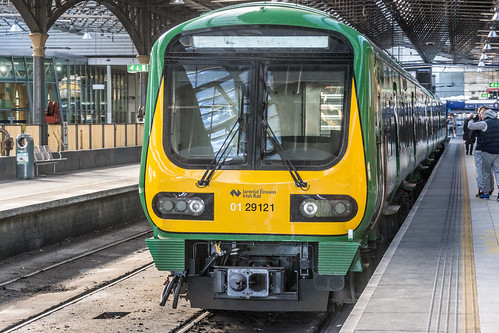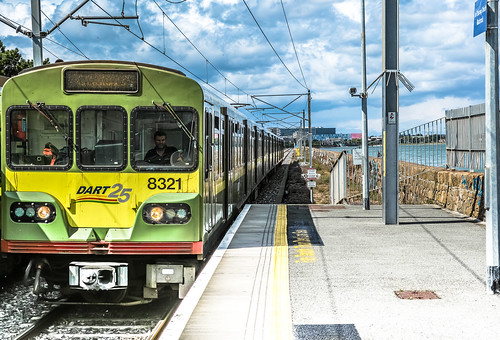RAIL TRANSPORT IN IRELAND
The history of rail transport in Ireland began only a decade later than that of Great Britain. By its peak in 1920, Ireland had 3,500 route miles (3,500 km). The current status is less than half that amount, with a large unserviced area around the border area between Northern Ireland and the Republic of Ireland.
Ireland's railways are run by (Iarnród Éireann) in the Republic and Northern Ireland Railways. The Railway Preservation Society of Ireland based in Whitehead, County Antrim runs preserved steam trains on the main line, with the Irish Traction Group preserving diesel locomotives, and operating on the main line. The Downpatrick & County Down Railway is the only self-contained full-size heritage railway in Ireland.
Although a railway between Limerick and Waterford had been authorised as early as 1826 (the same year as Britain's first locomotive-drawn line, the Liverpool and Manchester Railway)[1] it wasn't until 1834 that the first railway was built, the Dublin and Kingstown Railway (D&KR) between Westland Row in Dublin and Kingstown (Dún Laoghaire), a distance of 10 km (6 mi).[2] Due to local opposition the first terminus, Kingstown Harbour, was adjacent to the West Pier. It took a further three years before the line reached the site of the present station. The contractor was William Dargan, called "the founder of railways in Ireland", due to his participation in many of the main routes. The D&KR were notable in being one of the earliest dedicated commuter railways in the world. The planning undertaken was also noteworthy: a full survey of the existing road traffic was made, in addition to careful land surveys.
As well as the traffic survey showing existing volumes to be healthy, there was the potential from the ever expanding port at Kingstown. On 9 October 1834 the locomotive Hibernia brought a train the full route from the Westland Row terminus (now Pearse Station) to Kingstown. The railway was built to 1,435 mm (4 ft 8 1⁄2 in) standard gauge.
The entire route forms part of the present day Dublin Area Rapid Transit electrified commuter rail system.
The track gauge adopted by the mainline railways is 5 ft 3 in (1,600 mm). This unusual gauge is otherwise found only in the Australian states of Victoria, southern New South Wales (as part of the Victorian rail network) and South Australia (where it was introduced by the Irish railway engineer F. W. Sheilds), and in Brazil.
The first three railways all had different gauges: the Dublin and Kingstown Railway, 1,435 mm (4 ft 8 1⁄2 in); the Ulster Railway, 6 ft 2 in (1,880 mm); and the Dublin and Drogheda Railway, 5 ft 2 in (1,575 mm). Following complaints from the UR, the Board of Trade investigated the matter, and in 1843 recommended the use of 5 ft 3 in (1,600 mm) and that compensation be paid to the UR for the costs incurred in changing to the new gauge.
Ireland's railways are run by (Iarnród Éireann) in the Republic and Northern Ireland Railways. The Railway Preservation Society of Ireland based in Whitehead, County Antrim runs preserved steam trains on the main line, with the Irish Traction Group preserving diesel locomotives, and operating on the main line. The Downpatrick & County Down Railway is the only self-contained full-size heritage railway in Ireland.
Although a railway between Limerick and Waterford had been authorised as early as 1826 (the same year as Britain's first locomotive-drawn line, the Liverpool and Manchester Railway)[1] it wasn't until 1834 that the first railway was built, the Dublin and Kingstown Railway (D&KR) between Westland Row in Dublin and Kingstown (Dún Laoghaire), a distance of 10 km (6 mi).[2] Due to local opposition the first terminus, Kingstown Harbour, was adjacent to the West Pier. It took a further three years before the line reached the site of the present station. The contractor was William Dargan, called "the founder of railways in Ireland", due to his participation in many of the main routes. The D&KR were notable in being one of the earliest dedicated commuter railways in the world. The planning undertaken was also noteworthy: a full survey of the existing road traffic was made, in addition to careful land surveys.
As well as the traffic survey showing existing volumes to be healthy, there was the potential from the ever expanding port at Kingstown. On 9 October 1834 the locomotive Hibernia brought a train the full route from the Westland Row terminus (now Pearse Station) to Kingstown. The railway was built to 1,435 mm (4 ft 8 1⁄2 in) standard gauge.
The entire route forms part of the present day Dublin Area Rapid Transit electrified commuter rail system.
The track gauge adopted by the mainline railways is 5 ft 3 in (1,600 mm). This unusual gauge is otherwise found only in the Australian states of Victoria, southern New South Wales (as part of the Victorian rail network) and South Australia (where it was introduced by the Irish railway engineer F. W. Sheilds), and in Brazil.
The first three railways all had different gauges: the Dublin and Kingstown Railway, 1,435 mm (4 ft 8 1⁄2 in); the Ulster Railway, 6 ft 2 in (1,880 mm); and the Dublin and Drogheda Railway, 5 ft 2 in (1,575 mm). Following complaints from the UR, the Board of Trade investigated the matter, and in 1843 recommended the use of 5 ft 3 in (1,600 mm) and that compensation be paid to the UR for the costs incurred in changing to the new gauge.


